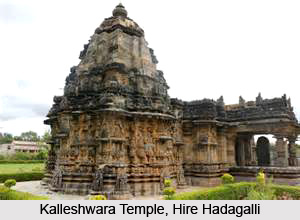 Kalleshwara Temple, also known as `Kalleshvara Temple` is present in Hire Hadagalli town of Bellary District in the southern Indian state of Karnataka. It is based in the Hoovina Hadagali Taluka in Bellary and was erected by the prime minister or `mahamatya`(Demarasa) to King Somesvara I, the ruler belonging to the empire of the Western Chalukyas, who was referred to as the `Lord of three worlds` and also `Trailokya Malladeva`. Somesvara I reigned till 1068 CE till 1042 CE. The Archaeological Survey of India has categorised this Indian temple as a protected monument.
Kalleshwara Temple, also known as `Kalleshvara Temple` is present in Hire Hadagalli town of Bellary District in the southern Indian state of Karnataka. It is based in the Hoovina Hadagali Taluka in Bellary and was erected by the prime minister or `mahamatya`(Demarasa) to King Somesvara I, the ruler belonging to the empire of the Western Chalukyas, who was referred to as the `Lord of three worlds` and also `Trailokya Malladeva`. Somesvara I reigned till 1068 CE till 1042 CE. The Archaeological Survey of India has categorised this Indian temple as a protected monument.
History of Kalleshwara Temple
Some art historians are of the view that Kalleshwara Temple portrays the Western Chalukyan form of architecture, established with the aide of soapstone. The temple has also been revered as `Bhimesvara-Demesvara`, as is suggested by an ancient Kannada inscription dating around 1057 CE, which also states that Vikramaditya VI was a prince or `kumara` of the Western Chalukya Dynasty. One gets to acquire information saying that the temple had been consecrated by Udayaditya under royal orders of Demarasa, from another Kannada inscription dating to 1108 CE. Yet another Kannada inscription of 1212 CE asserts that the temple was built by Veera Ballala, a ruler of the Hoysala Dynasty.
Architecture of Kalleshwara Temple
Two shrines are existent inside Kalleshwara Temple and it is known as `dvikuta`, while each of the shrines is equipped with a vestibule or `antarala` and sanctum sanctorum or `garbhagriha`. The vestibule leads visitors to the `sabhamandapa` or `navaranga`, which is actually the gathering hall of the temple. It appears as a closed hall possessing four pillars. However, only a singular `mukhamantapa` or main hall exists inside the temple, close to the southern direction. A `nandimantapa` or an open hall is present outside the main shrine premises, which boasts of a sculpture of `Nandi`, a companion of Lord Shiva, and it is developed into a small shrine. The external walls of the temple are beautifully adorned, particularly those of the main shrine and Chalukyan art-forms are represented on its closed halls. The niches of the temple pilasters possess idols of Hindu Gods, portraying forms of Goddess Lakshmi, Lord Indra, Lord Shiva and His consort Parvati. Unique cravings of `dvarapalas` or door keepers are present on the temple vestibule on which are existent figurines of `Manmatha`, the God of Love, `Rati` or the Goddess of Love. An image of Goddess Lakshmi in Her `Gajalakshmi` avatar is observed on the surface of the door lintel, which implies the image of the Goddess surrounded by elephant on both Her sides. The door eaves possess impressive images of Lord Shiva, Lord Brahma and `Keshava`, a form of Lord Vishnu.